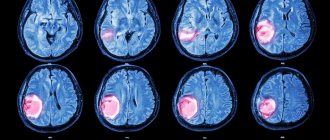Signs of cerebral palsy are a number of symptoms that indicate functional disorders against the background of structural and morphological damage to the brain. In this case, the violations concern specifically defined functions for which the area of the brain that has undergone pathological changes is responsible. Cerebral palsy is always accompanied by certain disorders of the human motor sphere, which are not progressive in nature. This means that a child with cerebral palsy experiences difficulties with a certain category of movements, coordination, and orientation in space. The form and nature of the disorders are directly related to the area of the brain whose neurons were damaged.
Classification of forms of cerebral palsy
Depending on the main cause of cerebral palsy and the location of the brain tissue disorder, several forms of the disease are distinguished based on a number of signs:
- Spastic diplegia is the most common and common form of cerebral palsy. With this type of disease, there is bilateral impairment of muscle function, with the legs, arms and face to a lesser extent being more affected. This form is characterized by skeletal deformities and pathological changes in the joints. Spastic diplegia most often results from the birth of a child with significant prematurity. The disease is often accompanied by a sharp decrease in the motor function of all four limbs, sometimes with partial or complete paralysis (tetraplegia). Against the background of pathology of the cranial nerves, disturbances in speech, auditory and visual functions may develop. With this form of cerebral palsy, if there are no serious impairments in intellectual development and significant impairments in the motor function of the hands, children have the highest chance of social adaptation and self-care.
- Double hemiplegia is one of the most complex and severe forms of cerebral palsy; its development is most often caused by chronic fetal hypoxia during gestation or early infancy (birth trauma). With this form, disorders such as spastic paralysis of all limbs, severe deformities of the torso, and stiffness of the joints develop, which begin to appear at a very early age. Against the background of motor dysfunctions, in approximately half of the diagnosed cases there are serious mental development disorders - cognitive (poor memory, lack of ability to cognition, lack of ability to understand the surrounding world), speech, visual, auditory disorders, pathological changes in the facial muscles, weak swallowing, sucking, chewing reflexes. Often children with this form of the disease suffer from epilepsy. The prognosis for such patients is disappointing; pathologies of motor functions in combination with impaired mental development lead to an inability to self-care.
- The hyperkinetic form is most often caused by hemolytic disease of the newborn, which is caused by an immunological conflict regarding the Rh factor or blood group of the mother and child. In severe forms of the disease, the newborn becomes intoxicated with antibodies from the mother's blood directed against the child's red blood cells. The disease is characterized by excessive motor reactions of muscles, which are caused by impaired muscle tone. Skeletal deformities in this form of the disease are absent or mild. Children experience various types of hyperkinesis - involuntary movements from slow worm-like to fast intermittent, spasms of the facial muscles, cramps of the limbs. Muscle tone can be variable from lethargy and weakness at rest to hypertonicity when moving. Often, with this form of cerebral palsy, hearing impairment and pathologies of motor function of the eyes are observed. Intellectually, such children can develop within normal limits; only the verbal function of communication is impaired with severe dysarthria (impaired pronunciation, speech breathing, articulation, tempo-rhythmic organization of speech).
- The atonic-astatic form is most often a consequence of birth trauma, chronic hypoxia and fetal development abnormalities during pregnancy. In most cases, this form of the disease is caused by damage to the tissue of the cerebellum, sometimes to the cerebral cortex in the frontal region. Children with this form of cerebral palsy are characterized by symptoms such as very low muscle tone, inconsistency of movements, poor coordination, and poor ability to maintain balance when walking. Sometimes speech disorders and intellectual pathologies of varying severity are also observed - from mental retardation to severe forms of mental retardation.
- The hemiplegic form is caused by a hematoma or hemorrhage with damage to one of the hemispheres of the brain, against which unilateral damage to the limbs develops. Hemiparesis (muscle weakening or partial paralysis) of the limbs of the right or left side may be accompanied by spasms and convulsions. In most cases, the motor function of the hand is more impaired. Depending on the degree of damage to the cerebral hemisphere, pathologies of speech function and mental retardation may also be observed.
Signs of early manifestations of cerebral palsy
Manifestations of cerebral palsy include increased excitability and motor disinhibition of nerve impulses, excessive activity and restlessness of muscle reactions, which leads to involuntary and uncontrolled movements. Against the background of increased activity of one muscle group, stiffness and paralysis of other motor functions may occur. In addition, cerebral palsy is often accompanied by disturbances and disorders of mental reactions, provoking abnormalities in the development of speech, hearing, vision and functional disorders of the digestive and urinary systems. Cerebral palsy is often accompanied by seizures of epilepsy.
Symptoms of cerebral palsy can appear in a child immediately after birth, that is, in the first weeks of a newborn’s life. However, it often happens that the manifestation of signs of the disease occurs gradually, which significantly complicates the timely diagnosis of cerebral palsy. In order to take adequate measures to treat and help the child, it is important to recognize them as early as possible.
It is quite difficult to diagnose cerebral palsy in newborn children, therefore, if a child develops symptoms such as sudden convulsions, tremors in the body, sharp muscle contractions, or, conversely, extremely weak motor activity of the limbs, inability to fix his gaze, intermittent, tense or weak breathing, or impaired sucking reflex, parents need to consult a pediatrician and pediatric neurologist.
One of the first manifestations of cerebral palsy in infants is that they begin to develop natural abilities much later. Symptomatically this is characterized by the following signs:
- Delayed motor development - delayed emergence of the ability to raise and hold one's head, development of the skill of rolling over from back to stomach and back, lack of purposeful movements when wanting to reach an object (toy), late development of the ability to sit and hold one's back. In the future, children with cerebral palsy have problems developing the skills of crawling, standing and walking.
- Children with cerebral palsy retain the reflexes that are characteristic of early infants much longer. For example, this applies to a situation where a child older than six months has a grasping reflex. Normally, this reflex is no longer present in children 4-5 months of age.
- Muscle tone disorders. Very often, at the initial stage of cerebral palsy, phenomena such as excessive relaxation or, on the contrary, increased tension of individual muscles or muscle groups can be observed. With this condition of the muscles, the child’s limbs may take on an incorrect, unnatural position. Excessive muscle relaxation in cerebral palsy manifests itself in the inability of normal movement, dangling of one or more limbs, and the inability to maintain a natural body position. Increased tension leads to stiffness and persistent muscle tone, which causes the child’s body to assume a forced, unnatural position. A typical example of such a symptom is arms or legs crossed like scissors.
- Unilateral limb activity. This can be noticed when a child consistently uses only one hand for manipulation. With normal development, children under one year old, if they want to reach an object, use both hands equally, and this factor does not depend on which side of the baby’s brain is dominant. That is, it does not matter whether he is right-handed or left-handed, in infancy he uses both hands with equal activity. If this is not the case, then this factor in itself can be considered alarming.
At the early (up to 5 months) and initial residual (from 6 months to 3 years) stages of cerebral palsy, pathologies of muscle tone provoke disturbances in the child’s motor abilities. This is manifested by the following symptoms:
- Excessive sharpness and suddenness of movements;
- Uncontrolled and completely aimless movements;
- Unnaturally slow and worm-like movements.
Often, even in infancy, children with cerebral palsy exhibit pathological signs such as limb cramps and trembling of individual muscles. This type of disorder affects about 30% of children with cerebral palsy.
Non-spastic, or full type
This type of cerebral palsy includes conditions in which the patient is unable to live independently. Here we are talking not only about physical, but also about mental disabilities. This group of diseases includes both severe forms of spastic cerebral palsy and choreoathetoid. The following types of non-spastic cerebral palsy are distinguished:
- dyskinetic - a condition in which there is an increase in muscle tone, convulsions or slow movements that are not controlled by the patient are possible;
- hyperkinetic type - relaxation is observed during sleep with constant twitching, especially of the face (similar to grimaces), while awake this affects the inability to swallow food;
- ataxic type - rare - motor abilities of the whole body are impaired, involuntary uncontrolled movements involve the arms, legs and torso;
- mixed type - there are cases in which the patient has symptoms of more than one type of cerebral palsy (for example, if both legs are affected - diplegia - and uncontrolled facial expressions - dyskinetic cerebral palsy).
It is not possible to talk about what long-term motor abnormalities and the severity of convulsive seizures the patient will suffer in children under three years of age. Yes, and mental development disorders can also be identified only at school, when the child should already be able to fully use his intellectual abilities. With any form of the full type of cerebral palsy, there are deviations in mental development, even if they are very small. This is due to the inability to use the physical functions of the body to understand the world and master certain skills and abilities.
Another consequence of the presence of cerebral palsy - hearing loss - is difficult to recognize in infants, but mandatory audiometry is provided in the maternity hospital, which allows for timely detection of this deviation. However, at a younger age, an attentive adult can understand that in some situations the child does not respond to quiet sounds.
Even physically healthy people are susceptible to various psychological problems. But for patients with cerebral palsy it is much more difficult. They look different from everyone else, they move awkwardly and not very beautifully, they are not able to speak correctly. Therefore, more than anyone else, they need understanding and correct attitude from others.
The life expectancy of people with cerebral palsy can be very normal. It depends on the severity, shape and rehabilitation efforts applied. Special compensatory equipment can provide serious assistance in relaxing paralyzed muscles and developing partially or completely inactive muscles. Improving physical capabilities greatly affects mental development - the quality of life and its duration increase. Rehabilitation of children with cerebral palsy can be very successful if you have good equipment, an integrated approach, unlimited patience and perseverance of loved ones.
Late residual stages of cerebral palsy - symptoms
Late stages of cerebral palsy are observed in older children, starting from 3 years. Based on already formed disorders, deformations, limited mobility and stiffness of joints, spasticity and pathological degeneration of muscle tissue, static disorders are established. Their consequence is paralytic and hyperkinetic syndromes.
Late symptoms of cerebral palsy include:
- Skeletal deformities. This type of disorder is observed in children with a spastic form of cerebral palsy. Due to improper movement and imbalance of the muscles, the process of bone formation is pathologically altered. This manifests itself in the form of curvatures, thickening of bones and joints.
- Joint contracture. Stiffness, deformation and pathological changes in joint tissues are caused by inadequate load distribution. In some cases, certain joints atrophy and lose mobility due to impaired muscle tone (myogenic contractures).
- Athetosis. Constant uncontrollable wriggling worm-like movements of the limbs on one or both sides, leading to an unnatural position and deformation (of the hands, feet).
- Ataxia. Characteristic coordination disorders and inability to maintain static or motor balance.
- Pathologies of muscle tone of varying severity. With reduced muscle tone (hypotonia), weakness and sluggishness of movements are observed. With increased tone (hypertonicity) - spasms, convulsions, tremors.
- Hyperkinesis. Involuntary, uncontrollable muscle contractions that cause abnormal movements of certain parts of the body - arms, legs, face.
- Maxillofacial deformities, dentition disorders. They arise as one of the forms of deformation of the skeletal bones of the skull and develop as a result of dysfunction of the facial muscles and other secondary factors of cerebral palsy.
- Delayed mental and mental development. It can manifest itself in various forms depending on the type and severity of damage to brain tissue - disturbance of spatial concepts, disorders of the emotional-volitional sphere, difficulty concentrating and switching attention, low memory capacity, lack of interest and motivation for learning.
In addition to the signs described above, it is important to note disturbances in visual functions (strabismus, optic nerve atrophy, myopia), hearing and speech development. In severe forms, functional disturbances in the processes of urination and bowel movements are also possible.
Treatment
Cerebral palsy is an incurable disease. But a variety of treatment methods help patients with cerebral palsy to minimize motor and other disorders and, thus, improve their quality of life. The brain injury or other factors that lead to cerebral palsy do not progress, but new symptoms may appear or progress as the child grows and develops.
Initial (initial) treatment
Exercise therapy is an important part of treatment that begins soon after a child is diagnosed and often continues throughout his or her life. This type of treatment may also be prescribed before diagnosis, depending on the child's symptoms.
Medications can help treat some of the symptoms of cerebral palsy and prevent complications. For example, antispasmodics and muscle relaxants help relax tight (spastic) muscles and increase range of motion. Anticholinergics can help improve limb movement or reduce drooling. Other medications may be used as symptomatic treatment (eg, anticonvulsants for seizures)
Permanent treatment
Permanent treatment for cerebral palsy (CP) focuses on continuing and adjusting existing treatment and adding new treatments as needed. Permanent treatment for cerebral palsy may include:
- Exercise therapy that can help a child become as mobile as possible. It may also help prevent the need for surgery. If the child has undergone surgical treatment, then intensive exercise therapy may be necessary for 6 months or more. Drug treatment must be constantly monitored in order to avoid possible side effects of drugs.
- Orthopedic surgery (for muscles, tendons, and joints) or dorsal rhizotomy (excision of nerves of damaged limbs), in the presence of severe problems with bones and muscles, ligaments, and tendons.
- Special orthopedic devices (braces, splints, orthoses).
- Behavioral therapy, in which a psychologist helps a child find ways to communicate with peers and this is also part of the treatment.
- Massage and manual therapy can also be used in the treatment of both the main symptoms of cerebral palsy and complications associated with impaired biomechanics of movement.
- Social adaptation. Modern technologies (computers) have made it possible to employ many patients with consequences of cerebral palsy.
Cerebral palsy - the main causes of development
The causes of the disease in the vast majority of cases are provoked by complications during pregnancy and pathologies in the first weeks of the baby’s life. The causes of cerebral palsy primarily include severe illnesses and pathological conditions that a woman suffered during pregnancy. The first group includes various infectious diseases that lead to intrauterine infection of the fetus. They are especially dangerous during the formation of brain structures.
The second group of reasons that provoke morphological and structural changes in the fetal cerebral cortex during pregnancy include traumatic brain injuries, falls, blows with the risk of brain injury in the child.
The main causes include the following factors:
- Prematurity and, as a consequence, underdevelopment of the brain;
- Chronic fetal hypoxia, causing oxygen starvation of the brain;
- Severe form of toxicosis;
- Severe infectious diseases;
- Lack of vitamins during intrauterine development;
- Severe chronic systemic diseases of the mother;
- Incompatibility of the blood of mother and fetus by Rh factor or group;
- Genetic predisposition (hereditary factor);
- Poisoning with toxic substances, heavy metals, medications.
The causes of postpartum brain tissue damage are most often associated with severe, protracted labor, birth injuries, asphyxia and infection of the baby in the first days of his life.
How to avoid the risks of cerebral palsy during pregnancy?
Cerebral palsy is a common disease. And it is almost always difficult to pinpoint the cause. But medical statistics collected over many years of research have made it possible to identify risk factors that are determined during a woman’s pregnancy. These data made it possible to compile a list of recommendations for expectant mothers that will help minimize the risks of cerebral palsy.
Recommendations for pregnant women to prevent cerebral palsy:
- completely eliminate smoking and any type of alcohol, especially in the early stages of pregnancy, when the main formation of organs and the central nervous system occurs;
- eat well;
- avoid contact with toxic substances;
- Do not miss scheduled doctor visits.
Recommendations for newborns to prevent cerebral palsy:
- do routine vaccinations on time;
- avoid contact of the newborn with infectious patients;
- do not contact someone with meningitis;
- see signs of newborn jaundice in a timely manner;
- Avoid using substances that contain heavy metals.
Advantages of osteopathy in the treatment of cerebral palsy
Like any severe neurological pathology, cerebral palsy is treated comprehensively using drug therapy, physiotherapy, massage techniques and physical therapy. Most of the developed methods of traditional medicine are aimed at relieving complications, improving blood supply to the central nervous system, as well as correcting pathological motor patterns.
Surgical treatment is used to eliminate severe deformities of joints and bones. However, all these methods only help eliminate the consequences and complications of the disease. It is worth noting that many of these treatments have a number of side effects and can be quite painful for the child.
Unlike classical medicine, osteopathic techniques make it possible to directly influence the causes of certain disorders, thanks to this they always have a much more effective result. Classification of osteopathy:
- Structural osteopathy - this set of techniques is used in the treatment of various diseases of the musculoskeletal system and the musculoskeletal system, both with limited and unlimited mobility.
- Craniosacral osteopathy is the use of various techniques for the treatment of neurological pathologies, including in children with impaired motor-sensory development, mental retardation and problems of social adaptation.
- Visceral osteopathy is a set of measures to influence the internal organs and functional systems of the body.
Methods of structural and craniosacral osteopathy are used to treat children with motor dysfunction caused by deformation of the skeleton, trunk and joints, as well as pathologies of muscle tone. For pathological complications of the functions of internal organs, visceral osteopathy techniques are used.
One of the important advantages of osteopathy is rightly considered to be the possibility of early diagnosis of diseases of the nervous system and damage to brain tissue. Even modern neurological diagnostic techniques can identify pathology from a certain age of the child, and an osteopath can distinguish disorders at the stage of very early development.
When diagnosing the nature and cause of disorders, the osteopath identifies specific areas of damage and develops an individual course and precise treatment regimen for each patient. For example, when a certain muscle group is blocked, techniques are initially used to relieve tension in muscle fibers or tightness of nerve endings. Relaxation makes it possible to improve blood flow and oxygen supply to damaged tissues. Subsequently, techniques are used to restore normal blood supply and nutrition to nerve tissue.
For each type of disorder in osteopathy, specific treatment and recovery methods have been developed. If a child at an early age develops such disorders as delayed physical or mental development, pathologies of reflexes, motor visual and auditory anomalies, then osteopathic methods can help to promptly influence the causes, up to their complete elimination.
The sooner a child receives help, the higher the chances of normal development and further socialization. An osteopathic doctor always collaborates with other specialized specialists - a neurologist, psychiatrist, ophthalmologist, orthopedist. The most effective results are obtained by combining the methods of classical medicine and osteopathy.








